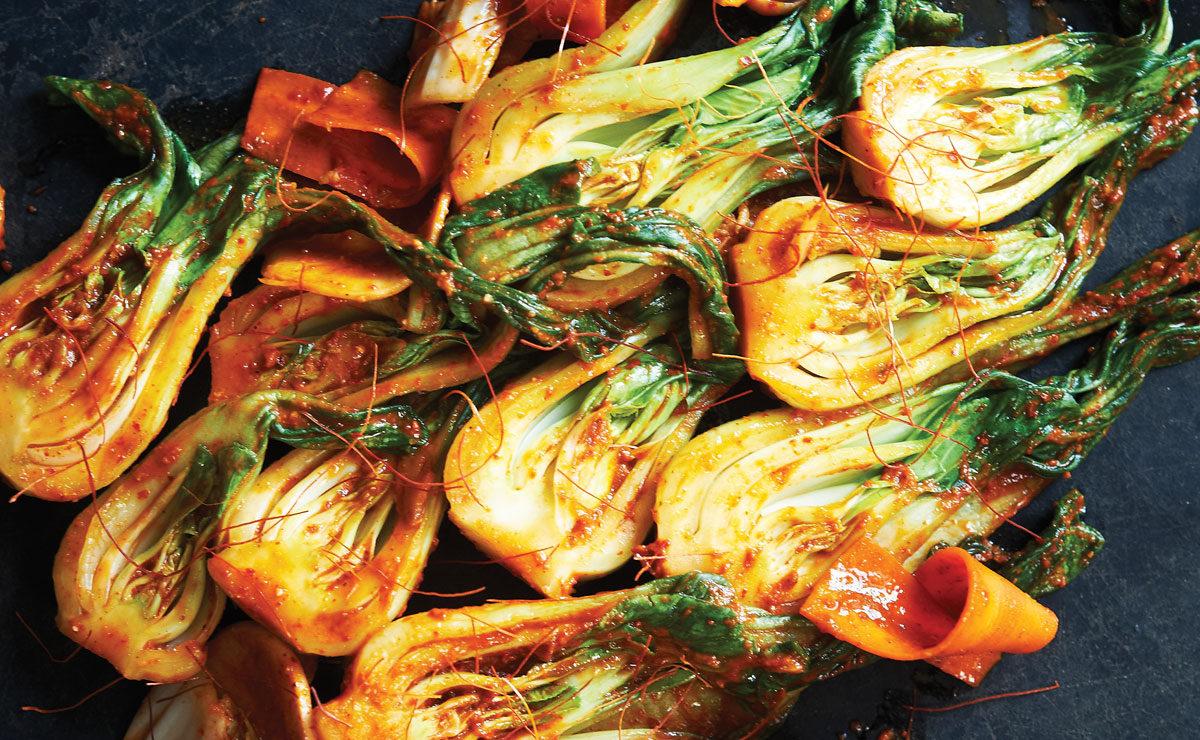Kimchi With Bok Choy and Mushrooms

I add my kimchi to roasted Brussels sprouts or to Chinese steamed buns with roasted pork belly, radish sprouts and a Korean spiced aioli. And I love it as a spicy Korean sauce blended in a Vitamix, strained and drizzled over Kumamoto oysters a la David Chang.
Ingredients
FOR KIMCHI BRINE:
½ cup kosher salt
4 qts. water
FOR KIMCHI:
2 lbs. Napa cabbage, sliced into 1-inch pieces and core removed
12 baby bok choy*, sliced in half lengthwise
2 large carrots, scrubbed, peeled lengthwise into strips with vegetable peeler, then cut into 2-inch pieces
2 bunches radish, scrubbed and sliced thinly into coins
2 bunches scallions, cut into 1-inch pieces
1 lb. fresh shiitake mushrooms, stems discarded and thinly sliced (or oyster mushrooms, torn into pieces)
3 Tbsp. black sesame seeds
2 Tbsp. coriander seeds
Large pinch Korean Pepper Threads**
FOR KIMCHI PASTE:
¼ lb. peeled garlic
3-inch knob ginger, peeled and cut into small pieces
¼ cup Korean pepper flakes
¼ cup fish sauce
3 Tbsp. jarred salted shrimp***
* Available at Global Foods Market, 421 N. Kirkwood Road, Kirkwood, 314.835.1112, globalfoodsmarket
** Available online at savoryspiceshop.com
*** Available in the refrigerator section at East East Oriental Store, 8619 Olive Blvd., St. Louis, 314.432.5590
Preparation
• In a large bowl, make the brine. Stir the salt into the water until it dissolves.
• Place all of the vegetables for the kimchi in an 8-quart pot or container and cover with the brine. Add more water if necessary to completely cover the vegetables. Using your hands, smash or lightly crush all of the vegetables. Cover the container with a pan or plate to keep the vegetables submerged. Let the vegetables brine for 3 to 6 hours at room temperature.
• After brining, rinse the vegetables and reserve the brine. Place the rinsed vegetables into a sanitized 6-quart container. This will be your fermenting container.
• Combine all of the kimchi paste ingredients in a food processor and pulse until smooth. Add this paste to the vegetables and mix by hand. (Gloves will help to keep your hands from turning red or being irritated by the pepper.)
• The vegetables and paste will be quite wet. You may need to add some of the reserved brine back to the mix until it is completely covered by liquid. Place a plate on top to keep the kimchi submerged. Cover the container with a lid or food film and leave at room temperature for 5 days, stirring the mixture each day with a clean utensil. The pH level will drop significantly within 2 to 3 days. This fermentation process will make it more acidic and safe, and bubbling will reduce. Kimchi that is still fermenting will have an effervescent taste. Many people love this taste. After about a week, the effervescence will dissipate and the flavor of your kimchi will become more complex. Make sure the kimchi is always submerged and covered. If you find any mold on the surface, just remove and discard it. The underlying kimchi should be fine.
• Start using the kimchi within a week or place it in the refrigerator for long-term aging. I find that squeezing some of the liquid from the kimchi is desirable before use.



